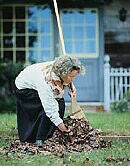
SUNDAY, Feb. 10 (HealthDay News) — Short stretches of physical activity — such as taking the stairs or raking leaves — throughout the day can be just as beneficial as a trip to the gym, according to a new study.
Researchers looked at more than 6,000 American adults and found that this “active lifestyle approach” appeared to be as effective as structured exercise in providing health benefits such as preventing high blood pressure, high cholesterol and the group of risk factors known as metabolic syndrome that increases the risk for coronary artery disease, stroke and type 2 diabetes.
“Our results suggest that engaging in an active lifestyle approach, compared to a structured exercise approach, may be just as beneficial in improving various health outcomes,” study author Paul Loprinzi said in an Oregon State University news release. “We encourage people to seek out opportunities to be active when the choice is available. For example, rather than sitting while talking on the phone, use this opportunity to get in some activity by pacing around while talking.”
Loprinzi was a doctoral student at Oregon State University when he conducted the study. He is now an assistant professor of exercise science at Bellarmine University in Louisville, Ky.
The researchers also found that 43 percent of adults who did short bouts of exercise met the federal physical activity guidelines of 30 minutes a day, compared with less than 10 percent of those who did longer exercise sessions.
“You hear that less than 10 percent of Americans exercise and it gives the perception that people are lazy,” study co-author Brad Cardinal, a professor of exercise and sports science at Oregon State, said in the news release. “Our research shows that more than 40 percent of adults achieved the exercise guidelines, by making movement a way of life.”
The study was published in the January/February issue of the American Journal of Health Promotion.
Many people say they don’t get enough exercise due to lack of time. These findings are promising in that they show that simply incorporating movement into everyday activities can provide health benefits, Cardinal said.
“This is a more natural way to exercise — just to walk more and move around a bit more,” he noted. “We are designed by nature as beings who are supposed to move. People get it in their minds: ‘If I don’t get that 30 minutes, I might as well not exercise at all.’ Our results really challenge that perception and give people meaningful, realistic options for meeting the physical activity guidelines.”
More information
The U.S. National Heart, Lung, and Blood Institute offers a guide to physical activity.

